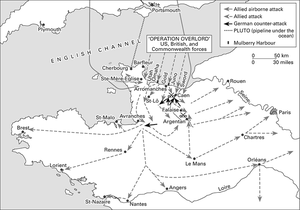
Normandy Campaign. The Allied plan ‘Operation Overlord’ succeeded in 1944 largely as a result of meticulous planning. U-boat bases in Brittany were captured in a lightning campaign by US troops, who then swung east. Other US forces, together with British and Commonwealth troops, defeated German defenders at the Battle of Falaise Gap. A swift drive through Normandy led to the capture of Rouen and Paris, and the advance into north-west Europe.
Source: MAPS IN MINUTES™ © RH Publications (1997)
(June–August 1944) An Allied counter-offensive in Europe in World War II. A series of landings were made on the beaches of Normandy, France, beginning on 6 June 1944 (D-Day). Five beaches had been designated for the Allied invasion, code name ‘Operation Overlord’, for which General Eisenhower was the supreme commander. British and Canadian troops fought across the eastern beaches, the US forces the western. Allied air forces destroyed most of the bridges over the Seine and the Loire, preventing the Germans from reinforcing their forward units. On D-Day plus 14 two vast steel-and-concrete artificial harbours (code name ‘Mulberry’) were towed across the English Channel. One was sunk by a freak storm, but the second was established at Arromanches, providing the main harbour for the campaign. Meanwhile 20 oil pipelines (code name ‘Pluto’ – pipe line under the ocean) were laid across the Channel to supply the thousands of vehicles now being landed.
The US forces under General Bradley had cut off the Cotentin Peninsula (18 June), and accepted the surrender of Cherbourg. The British army attacked towards Caen, securing it after heavy fighting (9 July) before advancing on Falaise. US troops broke through the German defences to capture the vital communications centre of Saint-Lô, cutting off the German force under Rommel. The Germans launched a counter-attack but were caught between the US and British armies in the ‘Falaise Gap’ and lost 60,000 men in fierce fighting. Field-Marshal Model, transferred from the Eastern Front, was unable to stem Patton’s advance, which now swept across France to Paris, while Montgomery moved his British army up the English Channel. Paris was liberated by General Leclerc on 26 August, and Brussels on 3 September. By 5 September more than two million troops, four million tonnes of supplies, and 450,000 vehicles had been landed, at the cost of some 224,000 Allied casualties.
- standby arrangement
- standby power
- standby time
- standing biomass
- standing crop
- standing wave
- stand of the tide
- standpoint
- standstill
- stanene
- Stanislaus II (1732–98)
- Stanley, Sir Henry Morton (1841–1904)
- Stanley, Wendell Meredith
- stannane
- stannate
- stannic compounds
- stannite
- stannous compounds
- Stanton number
- Stanton–Pannell chart
- stapes
- Staphylococcus
- staple product
- STAR
- star